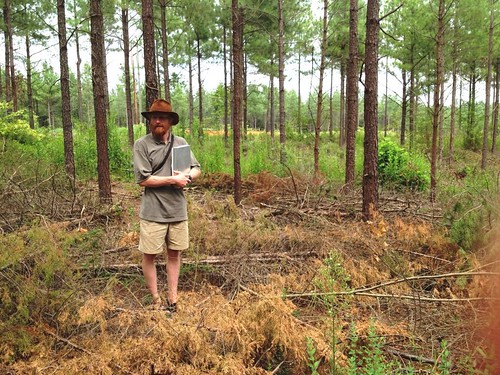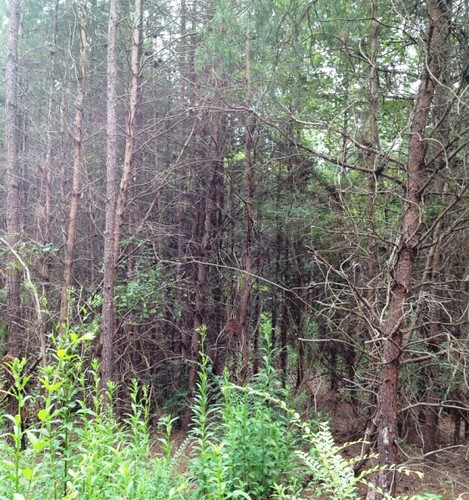
Fields-Johnson rotates his goats and sheep through the thinned stands to browse on honeysuckle and other understory vegetation. (Photo courtesy of Tom Ward and Colleen Rossier)
Throughout his life, Chris Fields-Johnson has been keenly aware of the need to preserve the natural landscapes, which provide us with clean air to breathe, water to drink and food to eat. As a graduate student of soil science at Virginia State and Polytechnic University, a forestry undergraduate, a student of Tom Brown, Jr.’s Tracker School and a former employee of the Virginia Department of Forestry, he also knows much of the science behind soil restoration and forestry. These experiences have given him a strong desire to turn his knowledge into action by managing land in the most beneficial way possible.
To make this dream a reality, he began converting a 250-acre loblolly pine plantation in Scottsville, Virginia., into a goat and sheep silvopasture system that resembles a pine savanna landscape. Silvopasture combines trees with forage and livestock production. The trees are managed for high-value sawlogs and, at the same time, provide shade and shelter for livestock and forage, reducing livestock stress and sometimes improving forage quality. Fields-Johnson and friends have spent many weekends thinning and pruning trees by hand, conducting controlled burns, fighting invasive plants and experimenting with forage establishment while they also learn how to raise goats and sheep.
Other farmers in the area—both beginners like Fields-Johnson and more seasoned ones—are also exploring silvopasture. Some are interested in silvopasture to decrease heat stress in the summer by providing shade for their animals. Others are interested in combining the long-term income opportunities from the trees and adding diversity to their livestock assets. Others are interested in the environmental benefits of trees and wish to keep them on large tracts of their property while still producing animals. Having a working silvopasture system in the area helps remove some of the unknowns or perceived risks that producers have when it comes to trying something new.

Fields-Johnson standing in his hand-thinned loblolly pine silvopasture. He plans to do a controlled-burn in this stand. (Photo courtesy of Tom Ward and Colleen Rossier)
What is silvopasture? How can I establish it on my land? How should I manage my trees? How can I establish forage for my animals as efficiently and effectively as possible? What type of grazing rotation do I need for my animals?
This risk and uncertainty is why it is critical for USDA Natural Resources Conservation Service (NRCS), the U.S. Forest Service, and partners (including technical service providers, Cooperative Extension, and State agricultural and forestry agencies) to be able to provide technical advice and financial assistance to help farmers and ranchers make the leap to new land management approaches.
In Virginia, NRCS was responsive to the local producers and beginning in October 2011 adopted a silvopasture establishment practice standard applicable throughout the state. This means that NRCS employees may now provide both technical and financial assistance to help producers establish silvopastures. “Silvopasture Establishment” has been an approved practice standard at the national level since 2002. The NRCS State office in Virginia adapted the national standard for Virginia and created a “Job Sheet” based on a national template that guides a conservation planner and a producer through the process of converting forest or pasture into silvopasture.
After learning about opportunities for assistance on a tour, Fields-Johnson followed up with his county forester and plans to pursue financial assistance through the Environmental Quality Incentives Program, EQIP. He also hopes to establish partnerships with researchers, professors and extension specialists who might wish to use the farm as a research and demonstration site. Demonstration areas are a valuable asset because they provide scientists with a practical laboratory to discover the best ways to implement silvopasture, and they provide extension agents with visible examples to educate others about silvopasture.
More information about this case study and others can be found in Agroforestry: USDA Reports to America, a comprehensive report that synthesizes the agroforestry efforts that USDA supported during FY 2011-2012. The report also outlines USDA resources that support agroforestry for landowners, natural resource professionals, researchers and other partners. A short version of the report is also available. More information about agroforestry is available on the USDA Agroforestry webpage as well as through the USDA National Agroforestry Center.

Loblolly pine plantation pre-thinning. (Photo courtesy of Tom Ward and Colleen Rossier)
No comments:
Post a Comment
Note: Only a member of this blog may post a comment.